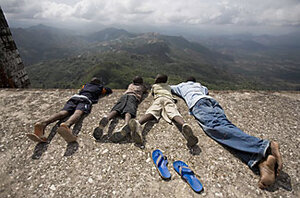Eyeing tourism, Haiti battles its violent reputation
Once a popular destination, it sees few tourists despite UN data that indicate country is among the region's safest.

Field trip: Students visit The Citadel fortress. Haiti sees few tourists despite UN data that indicate it is among the region's safest countries.
Ariana Cubillos/AP
PortAuPrince, Haiti
Kidnappings, gang violence, drug trafficking, corrupt police, flaming road blockades.
The reports out of the poorest country in the Western Hemisphere are enough to keep the most adventurous traveler away.
But according to security experts and officials from the United Nations peacekeeping mission in Port-au-Prince, Haiti is no more violent than any other country in Latin America.
"It's a big myth," says Fred Blaise, spokesman for the UN police force in Haiti. "Port-au-Prince is no more dangerous than any big city. You can go to New York and get pickpocketed and held at gunpoint. The same goes for cities in Mexico or Brazil."
Haiti's negative image has devastated its economy, whose once-booming tourism industry is now limited largely to aid workers, peacekeepers, and diplomats.
But UN data indicate that the country could be among the safest in the region.
According to the UN peacekeeping mission, there were 487 homicides in Haiti last year, or about 5.6 per 100,000 people. A 2007 joint UN-World Bank study estimated the Caribbean's average murder rate at 30 per 100,000, with Jamaica registering nearly nine times as many murders – 49 homicides per 100,000 people – as those recorded by the UN in Haiti.
In 2006, the Dominican Republic notched more than four times as many homicides per capita than Haiti – 23.6 per 100,000, according to the Central American Observatory on Violence.
"There is not a large amount of violence [in Haiti]," argues Gen. Jose Elito Carvalho Siquiera, the Brazilian former commander of the UN force in Haiti. "If you compare the levels of poverty here with those of São Paolo or other cities, there is more violence there."
The UN peacekeeping mission, known as Minustah, arrived in June 2004, three months after US troops whisked former President Jean-Bertrand Aristide into exile in Africa amid an armed rebellion.
The de facto interim government, propped up by the UN, the United States, France, and Canada, launched a repressive campaign against Mr. Aristide's supporters, igniting two years of gunfights in Port-au-Prince's slums among gangs, Haitian police, and UN peacekeepers.
Meanwhile, a wave of kidnappings raised tensions, with Minustah registering 1,356 in 2005 and 2006.
"The kidnappings shocked everyone because they hadn't happened in the past," says Mr. Blaise. "Still, when you compare the number of kidnappings here, I don't think it's more than anywhere else."
Last year, security improved markedly as the number of kidnappings dropped by nearly 70 percent, part of an overall improvement in security under President René Préval, elected in a landslide in February 2006. But earlier this month, thousands of demonstrators took to the streets in Port-au-Prince to protest an increase in kidnappings. At least 160 people have been kidnapped this year, according to Haitian and UN police, Reuters reports. In all of 2007, 237 people were kidnapped, the report said.
And in April, thousands of people took to the streets to demand lower food prices, sending images of burning tires and rock-throwing protesters around the world.
Still, gunshots are now seldom heard in Port-au-Prince, and attacks on foreigners are few. In recent months, American Airlines flights from Miami have been packed with Christian missionaries.
Some observers say even when the instability was at its worst, violence was usually limited to a few Port-au-Prince slums.
"If you compare Haiti to Iraq, to Afghanistan, to Rwanda, we don't even appear on the same scale," says Patrick Elie, a former defense secretary who heads a government commission on the possible creation of a new security force.
"We've had a tumultuous history, one characterized by political instability," says Mr. Elie. "But except for the war that we had to wage to obtain our freedom and independence from the French, Haiti has never known a level of violence comparable to that which has been waged in Europe, in America, and the European countries in Africa and Asia."
Viva Rio, a Brazilian-based violence reduction group that came to Haiti at the request of the UN, managed in March 2007 to convince warring gangs in Bel Air and neighboring downtown slums to abstain from violence in exchange for youth scholarships. "This would be unthinkable in Rio," says Rubem Cesar Fernandes, Viva Rio's director.
Unlike in Brazil, he says, Haiti's slum-based gangs have little involvement in the drug trade. "Right now in Haiti there is more interest in peace than war," he says. "[T]here is this prejudice that associates Haiti with danger, above all it seems, in the United States. Haiti seems to provoke fear from white North Americans."
Katherine Smith is one American who is not afraid. The young ethnographer has been coming here since 1999 to research voodoo and travels to poor neighborhoods using public transportation.
"The worst that has happened was being pickpocketed during Carnival, but that could happen anywhere," said Ms. Smith. "How little I've been targeted is remarkable given how visible I am."
But many aid workers, diplomats, and other foreigners live behind walls and concertina wire.
And except for émigrés visiting from abroad, tourism is near nonexistent. "It's so frustrating," says Jacqui Labrom, a former missionary who has organized guided tours of Haiti since 1997.
She says street demonstrations are easily avoided and rarely result in violence. "In the '50s and '60s, Haiti taught Cuba, Jamaica, the Dominican Republic how to do tourism.... If we didn't have such bad press, it would make such a difference."
